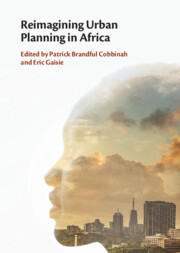Book contents
- Reimagining Urban Planning in Africa
- Reimagining Urban Planning in Africa
- Copyright page
- Contents
- Contributors
- Foreword
- Preface
- Acknowledgements
- Abbreviations
- Part I Understanding Sustainable Urban Planning in Africa
- Part II Case Studies on Urban Planning in African Countries
- 7 The Proliferation of Gated Communities
- 8 History, Practices, Challenges and Opportunities of Urban Planning in Zimbabwe
- 9 The Evolution and Nature of Urban Planning in Nigeria
- 10 Rethinking Urban Planning and Informal Settlement Upgrading
- 11 Urban Planning Challenges and Slum/Informal Housing Formation in Ogun State, Nigeria
- 12 The Proliferation of Slums in Cameroon
- 13 An Overview of Urban Planning in Tanzania
- Part III Sustainable Urban Planning in Africa
- Index
- References
12 - The Proliferation of Slums in Cameroon
What Do Internal Migrations Mean for Urban Planning?
from Part II - Case Studies on Urban Planning in African Countries
Published online by Cambridge University Press: 07 December 2023
- Reimagining Urban Planning in Africa
- Reimagining Urban Planning in Africa
- Copyright page
- Contents
- Contributors
- Foreword
- Preface
- Acknowledgements
- Abbreviations
- Part I Understanding Sustainable Urban Planning in Africa
- Part II Case Studies on Urban Planning in African Countries
- 7 The Proliferation of Gated Communities
- 8 History, Practices, Challenges and Opportunities of Urban Planning in Zimbabwe
- 9 The Evolution and Nature of Urban Planning in Nigeria
- 10 Rethinking Urban Planning and Informal Settlement Upgrading
- 11 Urban Planning Challenges and Slum/Informal Housing Formation in Ogun State, Nigeria
- 12 The Proliferation of Slums in Cameroon
- 13 An Overview of Urban Planning in Tanzania
- Part III Sustainable Urban Planning in Africa
- Index
- References
Summary
The nexus between internal migration and slums/informal settlements is appraised for urban areas in Cameroon using data from the 2014 Household Survey. In terms of methodology, the chapter employs multiple correspondence analysis to construct an index for slumsurban planning should factor internal migratory decisions of poor individuals that fuel urban informality when planning cities/informal settlements plus the Propensity Score Matching Technique. The main findings reveal that migrants are between 11% and 16% more likely to live in slums/informal settlements than non-migrants. Urban informality, perceived as migrants working in the informal sector, increases the chances of living in a slum/informal settlement. In rethinking African cities, urban planning should factor in internal migratory decisions of poor individuals that fuel urban informality when planning cities.
- Type
- Chapter
- Information
- Reimagining Urban Planning in Africa , pp. 196 - 215Publisher: Cambridge University PressPrint publication year: 2023



